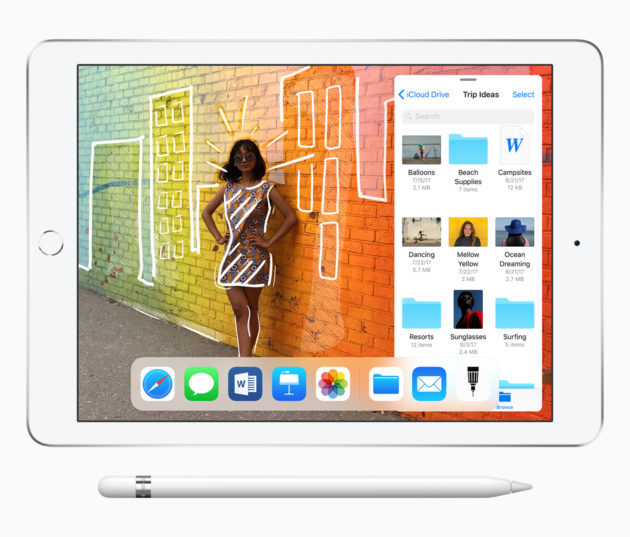
It’s on, Google. You too, Microsoft.
That might be the best way to sum up Apple’s big reveal of how it plans to compete with the current two leaders in the school market today: with a new 9.7″ iPad with Apple Pencil support, priced at $299 for schools (but $329 for everyone else), a lot more free software for students and teachers, and a general emphasis on augmented reality for learning.
Apple CEO Tim Cook began today’s event by nostalgically noting that education was one of Apple’s early core markets, going back 40 years to 1978 when Apple IIs ruled school computer labs. In front of some 300 teachers at Lane Tech College Prep high school in Chicago, Cook and other Apple execs outlined a broad array of edtech announcements in its first education-only event since 2012:
- A new iPad, priced at $299 for schools and $329 for consumers, is available to order today and shipping and in stores this week. Significantly, it comes with Apple Pencil drawing tool support (though Pencil itself is another $99 for consumers, or $89 for schools). The specs of the new iPad are a step up from its similarly priced predecessor: a 9.7″ Retina display, A10 Fusion chip, 10-hour battery, 8MP camera with 1080P HD video, gyroscope, GPS, accelerometer and compass, all in a one-pound device.
- A new version of iWork for the iPad, available today for download, with support for Apple Pencil inside Pages, Numbers, and Keynote. Digital books can be created directly inside Pages and don’t require a separate app.
For teachers and school administrators, Apple announced new Apple School Manager software to create Apple IDs for everyone in a school, as well as a free cloud-based Schoolwork app to distribute handouts to students and let educators assign students a specific activity within an app, using its new ClassKit API. The existing Classroom iPad app, which lets teachers see what students are doing on their iPads, will also be available for MacBooks in beta in June.
Permeating the event were repeated references to augmented reality, both from how the horsepower in the new iPad will “enable incredible AR experiences simply not possible on other devices,” to how the Swift Playgrounds app, which is used to teach kids to code, will be updated with an ARKit module.
Apple’s event at Lane Tech College Prep was billed as a “field trip” to showcase “creative new ideas for teachers and students.” Apple has had an ongoing relationship with the school, which was featured by Apple last December when it announced the expansion of its Everyone Can Code program.
Good morning, Chicago! We’re going back to school today for some exciting announcements in education. pic.twitter.com/7FhJ927reO
— Tim Cook (@tim_cook) March 27, 2018
Apple’s announcements today, especially the free software and apps, will likely help it compete more effectively with Google’s free G Suite for Education and related tools, and Microsoft’s Office 365 Education. But missing from the event was even stronger price competition against sub-$200 Chromebooks and Windows 10 devices which have taken share away from Apple due to their lower cost and integrated keyboards.
Apple has a long way to go to regain the high ground it once held in education technology. Market research firm Futuresource, which tracks shipments of computing devices to K-12 schools and districts, shows Apple’s share of mobile computing devices (that is, pretty much everything except desktops) in the U.S. peaked in 2012, at more than 50 percent. That was primarily due to the success of iPads, which were only two years old at the time, for one-to-one school computing and as potential textbook replacements.

However, the bloom rapidly faded from the iPad rose due to some high-profile botched implementations (such as in Los Angeles schools), and the need for additional-cost keyboards for online testing and writing in higher grades. In addition, unlike Apple hardware, Google’s and Microsoft’s devices come from a variety of partners, allowing for more price comparison shopping for cash-strapped school districts.
The iPad itself also continues to face new tablet competitors. Earlier this week, Google and Acer announced what is being billed as the first Chrome OS touchscreen tablet for education, the 9.7″ Acer Chromebook Tab 10, at a very iPad-like price point of $329.

One continuing edtech bright spot for Apple may be higher education, where MacBooks remain popular. But the higher education market — in which students and parents generally buy the laptops, not the institution — acts much more like the consumer market in which Apple does extremely well, and not as much like the government or enterprise markets more reflective of K-12 schools, where centralized education technology purchasing is done with taxpayer dollars.
Futuresource’s Ben Davis told GeekWire that with today’s announcements, “Apple has stuck to its guns and played to its strengths. As the market for classroom technologies matures and use cases evolve, Apple’s message should resonate with a growing population of schools.”
Davis said the expanded Pencil support and AR tools “may well entice new schools to go Apple.” And he said the new classroom software should help Apple compete with Google and Microsoft, “reducing the incentive for schools using Apple products to do so in combination with productivity tools from competitors.”



